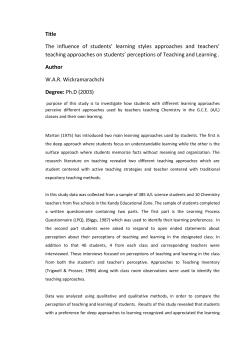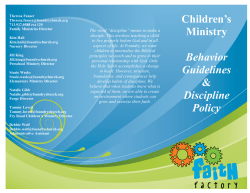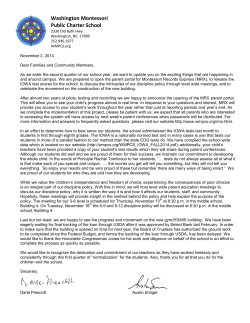
The Classroom Learning Environment Chapter 4
The Classroom Learning Environment Chapter 4 Minimum of Classroom Distractions ◦ Apply your knowledge of your students to create a pleasant classroom experience ◦ Initiate, practice and develop model behaviors that facilitate learning ◦ Create a conducive learning environment Based Based Based Based on on on on what you have learned what you prefer school/district mandates educational ethics and law Become an Effective Teacher Emotionally safe Important content and skills Value content and participation Single, most important factor influencing student learning Conducive Classroom Learning Environment IMPORTANT! Believe in yourself Believe in your students ◦ If you think they cannot learn, they will not. What do good teachers do? ◦ Know, when given support that all students can learn ◦ Expect the best ◦ Establish an environment that motivates students ◦ Manage efficiently Perceptions How much you know will not matter unless students perceive that ◦ ◦ ◦ ◦ ◦ The classroom environment is supportive. You care about their learning. You respect them as human beings. They are welcome in your class. Expectations are challenging but not impossible. ◦ Outcomes are worthy of their time and effort. Perceptions 1800’s ◦ ◦ ◦ ◦ Discipline, punishment Few finished 4th grade Theory assumed that all children were bad. Inappropriate behavior was students’ fault and must be punished Classroom Control 1900’s ◦ Students still misbehaving. ◦ Punitive measures did not work. ◦ Era of progressive behavior Children learn through play, experimentation, inquiry. Children should have a voice in what they learn ◦ Teachers’ job was to provide rich learning experiences Classroom Control Today ◦ Classroom control, not discipline ◦ Best teachers are in control of the events taking place in the classroom. ◦ Classroom management and organization Prevent inappropriate behavior. Help students develop self control. Have procedures in place to take care of misbehavior. ◦ Eclectic philosophy Classroom Control Behavior Modification ◦ Identify the behavior to be modified ◦ Record how often and when that behavior occurs ◦ Change by reinforcing desired behavior with positive reinforcement ◦ Choose appropriate reinforcement Use of computers for creativity (monitored) ◦ A PowerPoint instead of a paper Choices of how to use free time Passes for missed homework, extra points, etc. B. F. Skinner Assertive Discipline ◦ You have professional rights as an educator ◦ Students will choose how to behave in your room ◦ Clearly state expectation in firm voice and explain boundaries ◦ Plan a system of positive consequences Positive call/letter/e-mail home Certificates of award Special privileges ◦ Follow through Canter Logical Consequences ◦ Be fair, firm and friendly. ◦ Involve students in developing and implementing rules. ◦ Logical consequences for misbehavior ◦ ◦ ◦ ◦ ◦ Graffiti Peer pressure Show respect for self and others. Reason to belong. Recognize/encourage student achievement Recognize, but do not reward, students seeking attention, power or revenge. Dreikurs Reality Therapy ◦ Conditions of the present rule! ◦ Students have a responsibility to learn while at school and to maintain appropriate behavior. ◦ Students can make appropriate choices. ◦ Class meetings ◦ Students need to feel like they belong, are loved, in control, have freedom, can have fun. ◦ If they do not, they will fail. Glasser Communication Model ◦ Send messages about the situation, not about the child. ◦ Model the behavior you want. ◦ Send positive messages. Express feelings appropriately. Acknowledge student feelings. Give appropriate direction. Invite cooperation. Ginott Jones Model ◦ Properly structure your classroom so that students understand the rule and procedures. ◦ Maintain control by selecting appropriate instructional strategies. ◦ Build patterns of cooperative work. ◦ Develop backup methods for dealing with inappropriate student behavior. Jones http://www.youtube.com/watch?v=gHzTU YAOkPM
© Copyright 2025





















